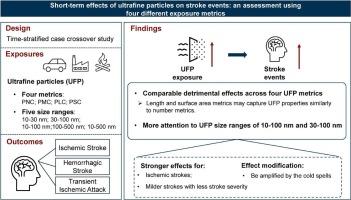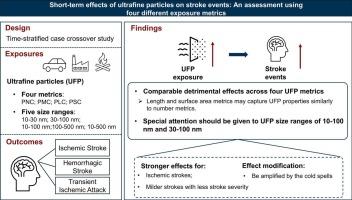超细颗粒对中风事件的短期影响:使用四种不同暴露指标的评估
IF 9.7
1区 环境科学与生态学
Q1 ENVIRONMENTAL SCIENCES
引用次数: 0
摘要
不同的超细颗粒(UFP)指标对中风的影响尚不清楚。本病例交叉研究调查了短期暴露于四种不同尺寸的UFP指标与卒中发生之间的关系。方法2006 - 2020年,选取污染较轻的德国奥格斯堡大学医院的19518例 S病例。同时,在奥格斯堡的固定监测点收集四种UFP指标的日平均值,包括颗粒数(PNC)、质量(PMC)、长度(PLC)和表面积(PSC)浓度。采用条件逻辑回归来评估UFP指标与卒中风险之间的关系。使用分层分析和相互作用分析来检验潜在的个体脆弱性和效应修正。结果卒中事件的风险升高在所有四个UFP指标中基本相似。在ufp滞后0-6 天内,每个四分位数范围内卒中增加的优势比(95 %置信区间)为:PNC为4.76 % (1.06;8.60),PMC为3.99 % (0.93;7.13),PLC为4.52 % (1.11;8.05),PSC为4.14 %(1.00;7.38)。主要发现10-100 nm和30-100 nm的尺寸分数与中风有稳定的联系。UFP的累积效应对缺血性中风和轻微中风的严重程度较低更为明显。寒潮期可能会夸大ufp的影响。结论ufp指标,如颗粒长度和表面积浓度,除了颗粒数量,可能提供有价值的见解,颗粒的性质与中风的风险。扩大对不定期空气污染的实时、大小隔离监测是减轻与交通有关的空气污染对健康影响的一项有效战略。本文章由计算机程序翻译,如有差异,请以英文原文为准。


Short-term effects of ultrafine particles on stroke events: an assessment using four different exposure metrics
Background
The effects of different ultrafine particle (UFP) metrics on strokes are unclear. This case-crossover study investigated the association between short-term exposure to four size-segregated UFP metrics and stroke occurrence.
Methods
From 2006 to 2020, we included 19,518 stroke cases from the University Hospital Augsburg, Germany, a less polluted area. Meanwhile, daily averages of four UFP metrics, including particle number (PNC), mass (PMC), length (PLC), and surface area (PSC) concentrations, were collected from fixed monitoring sites in Augsburg. Conditional logistic regression was employed to assess the association between UFP metrics and stroke risk. Potential individual vulnerability and effect modification were examined using the stratified and interaction analyses.
Results
Elevated risk of stroke events was largely similar across all four UFP metrics. The odds ratios (95 % confidence intervals) of strokes for each interquartile range increase in lag 0–6 days of UFPs were 4.76 % (1.06; 8.60) for PNC, 3.99 % (0.93; 7.13) for PMC, 4.52 % (1.11; 8.05) for PLC, and 4.14 % (1.00; 7.38) for PSC. Stable associations with strokes were mainly found for the size fractions of 10–100 nm and 30–100 nm. The cumulative effects of UFP were more pronounced for ischemic strokes and minor strokes with a lower severity. Cold spells might exaggerate the effects of UFPs.
Conclusion
UFP metrics like particle length and surface area concentration, aside from particle number, may provide valuable insights into particle properties relevant to stroke risk. Expanding real-time, size-segregated monitoring of UFPs represents an effective strategy to mitigate the health impacts of traffic-related air pollution.
求助全文
通过发布文献求助,成功后即可免费获取论文全文。
去求助
来源期刊

Environment International
环境科学-环境科学
CiteScore
21.90
自引率
3.40%
发文量
734
审稿时长
2.8 months
期刊介绍:
Environmental Health publishes manuscripts focusing on critical aspects of environmental and occupational medicine, including studies in toxicology and epidemiology, to illuminate the human health implications of exposure to environmental hazards. The journal adopts an open-access model and practices open peer review.
It caters to scientists and practitioners across all environmental science domains, directly or indirectly impacting human health and well-being. With a commitment to enhancing the prevention of environmentally-related health risks, Environmental Health serves as a public health journal for the community and scientists engaged in matters of public health significance concerning the environment.
 求助内容:
求助内容: 应助结果提醒方式:
应助结果提醒方式:


